A New Design Method for Class-E Power Amplifiers Using Artificial Intelligence Modeling for Wireless Power Transfer Applications
Abstract
1. Introduction
2. Class-E PA Circuit
3. Neural Network Modeling
3.1. Proposed Model Implementation
3.2. Initial Evaluation of the Hybrid ANN-Optimization Algorithms
3.2.1. MLP-ICA Neural Optimization Network
| Neural network | MLP |
| Training Algorithm | ICA |
| Input Layer Neurons | 4 |
| Hidden Layer Neurons | 7-7 |
| Output Layer Neurons | 6 |
| Number of Iterations or Generations | 100 |
| Number of Countries | 500 |
| Number of Initial Imperialists | 30 |
| Activation Function | tansig |
3.2.2. MLP-Genetic Neural Optimization Network
| Neural network | MLP |
| Training Algorithm | GA |
| Input Layer Neurons | 4 |
| Hidden Layer Neurons | 7-7 |
| Output Layer Neurons | 6 |
| Number of Iterations or Generations | 100 |
| Population Size | 500 |
| Activation Function | tansig |
3.2.3. MLP-PSO Neural Optimization Network
| Neural network | MLP |
| Training algorithm | PSO |
| Input layer neurons | 4 |
| Hidden layer neurons | 7-7 |
| Output layer neurons | 6 |
| Number of iterations or generations | 100 |
| Population Size | 500 |
| Activation function | Tansig |
| Cognition Coefficient | 2 |
| Social Coefficient | 2 |
| Error | ANN-ICA Test | ANN-ICA Train | ANN-GA Test | ANN-GA Train | ANN-PSO Test | ANN-PSO Train |
|---|---|---|---|---|---|---|
| MAE, R (Ω) | 8.20 | 8.97 | 15.68 | 10.97 | 7.33 | 3.34 |
| RMSE, R (Ω) | 15.31 | 11.69 | 21.47 | 16.36 | 11.72 | 4.50 |
| MAE, L (uH) | 11.04 | 10.63 | 21.38 | 16.70 | 7.95 | 6.49 |
| RMSE, L (uH) | 12.88 | 14.46 | 33.55 | 20.47 | 9.55 | 7.97 |
| MAE, C (nF) | 0.25 | 0.22 | 0.03 | 0.02 | 0.35 | 0.18 |
| RMSE, C (nF) | 0.36 | 0.31 | 0.04 | 0.02 | 0.56 | 0.25 |
| MAE, Csh (nF) | 0.22 | 0.28 | 0.49 | 0.33 | 0.34 | 0.24 |
| RMSE, Csh (nF) | 0.28 | 0.36 | 0.67 | 0.40 | 0.49 | 0.37 |
| MAE, vo (V) | 1.92 | 2.37 | 3.74 | 3.19 | 0.58 | 0.45 |
| RMSE, vo (V) | 2.44 | 2.83 | 4.41 | 3.96 | 0.90 | 0.67 |
| MAE, vs (V) | 8.92 | 6.93 | 12.60 | 9.32 | 1.12 | 1.15 |
| RMSE, vs (V) | 11.67 | 8.96 | 16.52 | 11.73 | 1.43 | 1.50 |
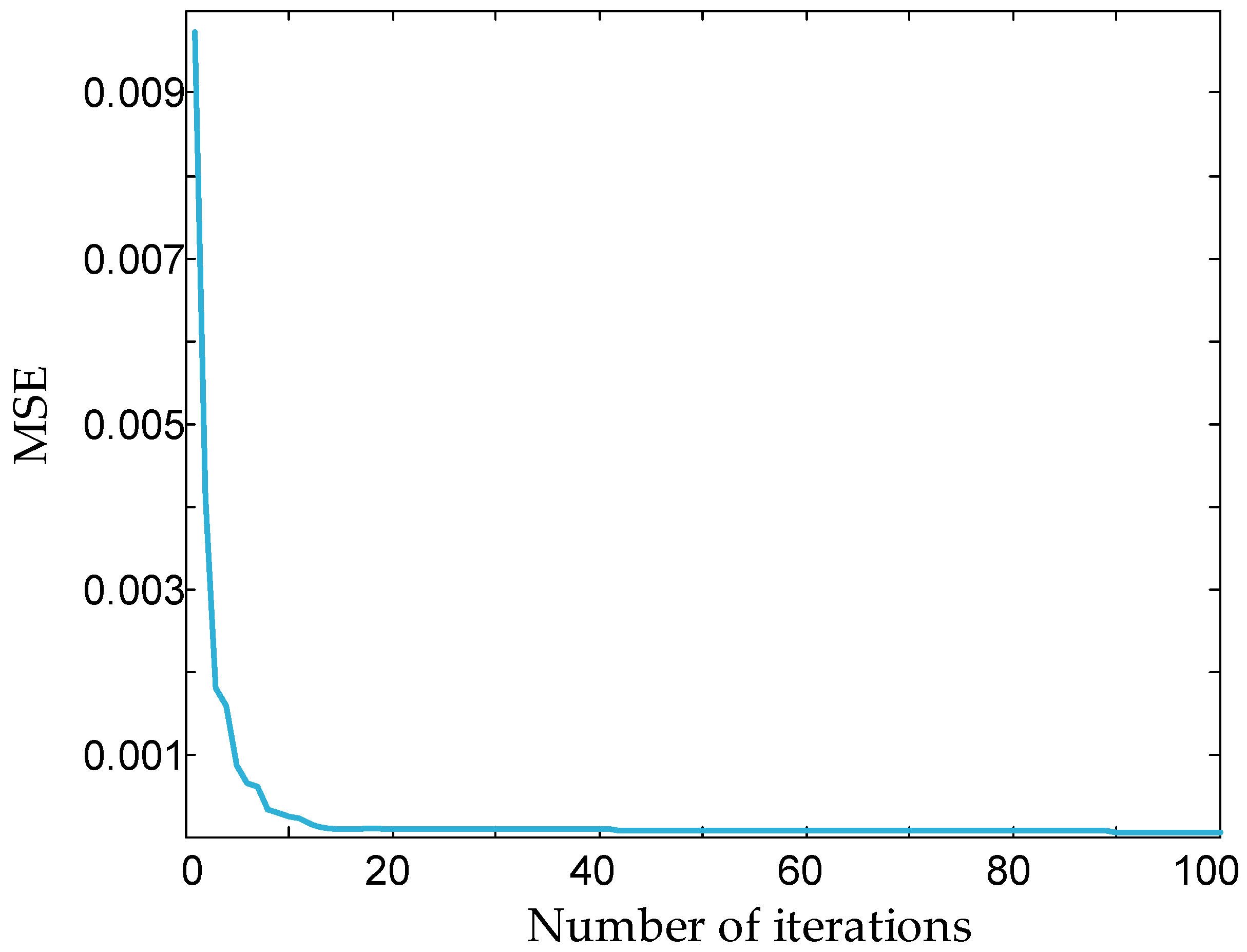
4. Results and Discussion
4.1. The Proposed Model Comparison
4.2. Design Examples
4.3. Result Comparison
5. Conclusions
Author Contributions
Funding
Data Availability Statement
Conflicts of Interest
References
- Tesla, N. Electrical Energy. U.S. Patent 1,119,732, 1 December 1914. [Google Scholar]
- Liu, H.; Shao, Q.; Fang, X. Modeling and optimization of class-E amplifier at subnominal condition in a wireless power transfer system for biomedical implants. IEEE Trans. Biomed. Circuits Syst. 2016, 11, 35–43. [Google Scholar] [CrossRef] [PubMed]
- Rana, M.M.; Xiang, W.; Wang, E.; Li, X.; Choi, B.J. Internet of Things infrastructure for wireless power transfer systems. IEEE Access 2018, 6, 19295–19303. [Google Scholar] [CrossRef]
- Li, S.; Mi, C.C. Wireless power transfer for electric vehicle applications. IEEE J. Emerg. Sel. Top. Power Electron. 2014, 3, 4–17. [Google Scholar]
- Xie, L.; Shi, Y.; Hou, Y.T.; Lou, A. Wireless power transfer and applications to sensor networks. IEEE Wirel. Commun. 2013, 20, 140–145. [Google Scholar]
- Zhang, Z.; Pang, H.; Georgiadis, A.; Cecati, C. Wireless power transfer—An overview. IEEE Trans. Ind. Electron. 2018, 66, 1044–1058. [Google Scholar] [CrossRef]
- Xue, R.-F.; Cheng, K.-W.; Je, M. High-efficiency wireless power transfer for biomedical implants by optimal resonant load transformation. IEEE Trans. Circuits Syst. I Regul. Pap. 2012, 60, 867–874. [Google Scholar] [CrossRef]
- Hayati, M.; Roshani, S.; Kazimierczuk, M.K.; Sekiya, H. A class-E power amplifier design considering MOSFET nonlinear drain-to-source and nonlinear gate-to-drain capacitances at any grading coefficient. IEEE Trans. Power Electron. 2015, 31, 7770–7779. [Google Scholar] [CrossRef]
- Hayati, M.; Roshani, S.; Kazimierczuk, M.K.; Sekiya, H. Analysis and design of class E power amplifier considering MOSFET parasitic input and output capacitances. IET Circuits Devices Syst. 2016, 10, 433–440. [Google Scholar] [CrossRef]
- Jamshidi, M.B.; Roshani, S.; Talla, J.; Sharifi-Atashgah, M.S.; Roshani, S.; Peroutka, Z. Cloud-based Machine Learning Techniques Implemented by Microsoft Azure for Designing Power Amplifiers. In Proceedings of the 2021 IEEE 12th Annual Ubiquitous Computing, Electronics & Mobile Communication Conference (UEMCON), New York, NY, USA, 1–4 December 2021; pp. 41–44. [Google Scholar]
- Tirado-Mendez, A.; Jardon-Aguilar, H.; Flores-Leal, R.; Andrade-Gonzalez, E.; Reyes-Ayala, M. Low-harmonic distortion in single-ended and push-pull class E power amplifier by using slotted microstrip lines. AEU-Int. J. Electron. Commun. 2010, 64, 66–74. [Google Scholar] [CrossRef]
- Sharma, T.; Aflaki, P.; Helaoui, M.; Ghannouchi, F.M. Broadband GaN class-E power amplifier for load modulated delta sigma and 5G transmitter applications. IEEE Access 2018, 6, 4709–4719. [Google Scholar] [CrossRef]
- Sokal, N.O.; Sokal, A.D. Class EA new class of high-efficiency tuned single-ended switching power amplifiers. IEEE J. Solid-State Circuits 1975, 10, 168–176. [Google Scholar] [CrossRef]
- Kazimierczuk, M.K. RF Power Amplifiers; John Wiley & Sons: Hoboken, NJ, USA, 2014. [Google Scholar]
- Wei, X.; Sekiya, H.; Kuroiwa, S.; Suetsugu, T.; Kazimierczuk, M.K. Design of class-E amplifier with MOSFET linear gate-to-drain and nonlinear drain-to-source capacitances. IEEE Trans. Circuits Syst. I Regul. Pap. 2011, 58, 2556–2565. [Google Scholar] [CrossRef]
- Suetsugu, T.; Kazimierczuk, M.K. Design procedure of class-E amplifier for off-nominal operation at 50% duty ratio. IEEE Trans. Circuits Syst. I Regul. Pap. 2006, 53, 1468–1476. [Google Scholar] [CrossRef]
- Mury, T.; Fusco, V.F. Inverse class-E amplifier with transmission-line harmonic suppression. IEEE Trans. Circuits Syst. I Regul. Pap. 2007, 54, 1555–1561. [Google Scholar] [CrossRef]
- Chokkalingam, B.; Padmanaban, S.; Leonowicz, Z.M. Class E power amplifier design and optimization for the capacitive coupled wireless power transfer system in biomedical implants. Energies 2017, 10, 1409. [Google Scholar]
- Bertoni, N.; Frattini, G.; Massolini, R.G.; Pareschi, F.; Rovatti, R.; Setti, G. An analytical approach for the design of class-E resonant DC–DC converters. IEEE Trans. Power Electron. 2016, 31, 7701–7713. [Google Scholar] [CrossRef]
- Garcia, J.A.; Popović, Z. Class-E rectifiers and power converters: The operation of the class-E topology as a power amplifier and a rectifier with very high conversion efficiencies. IEEE Microw. Mag. 2018, 19, 67–78. [Google Scholar] [CrossRef]
- Srimuang, P.; Puangngernmak, N.; Chalermwisutkul, S. 13.56 MHz class E power amplifier with 94.6% efficiency and 31 watts output power for RF heating applications. In Proceedings of the 2014 11th International Conference on Electrical Engineering/Electronics, Computer, Telecommunications and Information Technology (ECTI-CON), Nakhon Ratchasima, Thailand, 14–17 May 2014; pp. 1–5. [Google Scholar]
- Dai, W.; Tang, W.; Cai, C.; Deng, L.; Zhang, X. Wireless power charger based on class E amplifier with the maximum power point load consideration. Energies 2018, 11, 2378. [Google Scholar] [CrossRef]
- Sutor, A.; Heining, M.; Buchholz, R. A class-e amplifier for a loosely coupled inductive power transfer system with multiple receivers. Energies 2019, 12, 1165. [Google Scholar] [CrossRef]
- Hashemi, M.; Zhou, L.; Shen, Y.; De Vreede, L.C. A highly linear wideband polar class-E CMOS digital Doherty power amplifier. IEEE Trans. Microw. Theory Tech. 2019, 67, 4232–4245. [Google Scholar] [CrossRef]
- Barzgari, M.; Ghafari, A.; Nikpaik, A.; Medi, A. Even-harmonic class-E CMOS oscillator. IEEE J. Solid-State Circuits 2021, 57, 1594–1609. [Google Scholar] [CrossRef]
- Parandin, F.; Karkhanehchi, M.M. Low size all optical XOR and NOT logic gates based on two-dimensional photonic crystals. Majlesi J. Electr. Eng. 2019, 13, 1–5. [Google Scholar]
- Vahdati, A.; Parandin, F. Antenna patch design using a photonic crystal substrate at a frequency of 1.6 THz. Wirel. Pers. Commun. 2019, 109, 2213–2219. [Google Scholar] [CrossRef]
- Karkhanehchi, M.M.; Parandin, F.; Zahedi, A. Design of an all optical half-adder based on 2D photonic crystals. Photonic Netw. Commun. 2017, 33, 159–165. [Google Scholar] [CrossRef]
- Parandin, F. Ultra-compact terahertz all-optical logic comparator on GaAs photonic crystal platform. Opt. Laser Technol. 2021, 144, 107399. [Google Scholar] [CrossRef]
- Planat, L.; Ranadive, A.; Dassonneville, R.; Martínez, J.P.; Léger, S.; Naud, C.; Buisson, O.; Hasch-Guichard, W.; Basko, D.M.; Roch, N. Photonic-crystal Josephson traveling-wave parametric amplifier. Phys. Rev. X 2020, 10, 021021. [Google Scholar] [CrossRef]
- Kotb, A.; Zoiros, K.E.; Guo, C. Ultrafast performance of all-optical AND and OR logic operations at 160 Gb/s using photonic crystal semiconductor optical amplifier. Opt. Laser Technol. 2019, 119, 105611. [Google Scholar] [CrossRef]
- Hayati, M.; Roshani, S.; Roshani, S.; Kazimierczuk, M.K.; Sekiya, H. Design of class E power amplifier with new structure and flat top switch voltage waveform. IEEE Trans. Power Electron. 2017, 33, 2571–2579. [Google Scholar] [CrossRef]
- Roshani, G.H.; Roshani, S.; Nazemi, E.; Roshani, S. Online measuring density of oil products in annular regime of gas-liquid two phase flows. Measurement 2018, 129, 296–301. [Google Scholar] [CrossRef]
- Chen, T.-C.; Taylan, O.; Alizadeh, S.M.; Yilmaz, M.T.; Nazemi, E.; Balubaid, M.; Roshani, G.H.; Karaboga, D. Investigation of Time-Domain Feature Selection and GMDH Neural Network Application for Determination of Volume Percentages in X-Ray-Based Two-Phase Flow Meters. MAPAN 2022, 1–13. [Google Scholar] [CrossRef]
- Roshani, M.; Sattari, M.A.; Ali, P.J.M.; Roshani, G.H.; Nazemi, B.; Corniani, E.; Nazemi, E. Application of GMDH neural network technique to improve measuring precision of a simplified photon attenuation based two-phase flowmeter. Flow Meas. Instrum. 2020, 75, 101804. [Google Scholar] [CrossRef]
- Roshani, M.; Phan, G.; Roshani, G.H.; Hanus, R.; Nazemi, B.; Corniani, E.; Nazemi, E. Combination of X-ray tube and GMDH neural network as a nondestructive and potential technique for measuring characteristics of gas-oil–water three phase flows. Measurement 2021, 168, 108427. [Google Scholar] [CrossRef]
- Zirak, A.R.; Roshani, S. Design and modeling of RF power amplifiers with radial basis function artificial neural networks. Int. J. Adv. Comput. Sci. Appl. 2016, 7, 227–231. [Google Scholar]
- Mehrafrooz, A.; He, F.; Lalbakhsh, A. Introducing a Novel Model-Free Multivariable Adaptive Neural Network Controller for Square MIMO Systems. Sensors 2022, 22, 2089. [Google Scholar] [CrossRef]
- Jamshidi, M.B.; Lalbakhsh, A.; Mohamadzade, B.; Siahkamari, H.; Mousavi, S.M.H. A novel neural-based approach for design of microstrip filters. AEU-Int. J. Electron. Commun. 2019, 110, 152847. [Google Scholar] [CrossRef]
- Jamshidi, M.; Lalbakhsh, A.; Lotfi, S.; Siahkamari, H.; Mohamadzade, B.; Jalilian, J. A neuro-based approach to designing a Wilkinson power divider. Int. J. RF Microw. Comput.-Aided Eng. 2020, 30, e22091. [Google Scholar] [CrossRef]
- Wang, M.; Feng, J.; Shi, Y.; Shen, M.; Jing, J. A Novel PSO-Based Transfer Efficiency Optimization Algorithm for Wireless Power Transfer. Prog. Electromagn. Res. C 2018, 85, 63–75. [Google Scholar] [CrossRef][Green Version]
- ELSayed, K.G.; Elessawy, N.A.; ElShenawy, A.K. Wireless power transfer system modelling based on neural network with adaptive filtering. In Proceedings of the 2015 International Conference on High Performance Computing & Simulation (HPCS), Amsterdam, The Netherlands, 20–24 July 2015; pp. 305–310. [Google Scholar]
- He, L.; Zhao, S.; Wang, X.; Lee, C.-K. Artificial Neural Network-Based Parameter Identification Method for Wireless Power Transfer Systems. Electronics 2022, 11, 1415. [Google Scholar] [CrossRef]
- Ali, A.; Mohd Yasin, M.N.; Jusoh, M.; Ahmad Hambali, N.A.M.; Abdul Rahim, S.R. Optimization of wireless power transfer using artificial neural network: A review. Microw. Opt. Technol. Lett. 2020, 62, 651–659. [Google Scholar] [CrossRef]
- Karimi, H.; Yousefi, F. Application of artificial neural network–genetic algorithm (ANN–GA) to correlation of density in nanofluids. Fluid Phase Equilibria 2012, 336, 79–83. [Google Scholar] [CrossRef]
- Toghyani, S.; Ahmadi, M.H.; Kasaeian, A.; Mohammadi, A.H. Artificial neural network, ANN-PSO and ANN-ICA for modelling the Stirling engine. Int. J. Ambient. Energy 2016, 37, 456–468. [Google Scholar] [CrossRef]
- Atashpaz-Gargari, E.; Lucas, C. Imperialist competitive algorithm: An algorithm for optimization inspired by imperialistic competition. In Proceedings of the 2007 IEEE Congress on Evolutionary Computation, Singapore, 25–28 September 2007; pp. 4661–4667. [Google Scholar]
- Mikaeil, R.; Haghshenas, S.S.; Haghshenas, S.S.; Ataei, M. Performance prediction of circular saw machine using imperialist competitive algorithm and fuzzy clustering technique. Neural Comput. Appl. 2018, 29, 283–292. [Google Scholar] [CrossRef]
- Torquato, M.F.; Fernandes, M.A. High-performance parallel implementation of genetic algorithm on fpga. Circuits Syst. Signal Process. 2019, 38, 4014–4039. [Google Scholar] [CrossRef]
- Szopos, E.; Neag, M.; Saracut, I.; Popescu, V.; Topa, M. Synthesis tool based on genetic algorithm for FIR filters with user-defined magnitude characteristics. Circuits Syst. Signal Process. 2016, 35, 253–279. [Google Scholar] [CrossRef]
- Papadimitriou, A.; Bucher, M. Multi-objective low-noise amplifier optimization using analytical model and genetic computation. Circuits Syst. Signal Process. 2017, 36, 4963–4993. [Google Scholar] [CrossRef]
- Goldberg David, E.; Henry, H. Genetic algorithms and machine learning. Mach Learn 1988, 3, 95–99. [Google Scholar] [CrossRef]
- Kennedy, J. Particle swarm optimization. Encyclopedia of machine learning. Springer 2011, 760, 766. [Google Scholar]
- De, B.P.; Kar, R.; Mandal, D.; Ghoshal, S.P. Particle swarm optimization with aging leader and challengers for optimal design of analog active filters. Circuits Syst. Signal Process. 2015, 34, 707–737. [Google Scholar] [CrossRef]
- Jeong, S.; Lin, T.-H.; Tentzeris, M.M. A real-time range-adaptive impedance matching utilizing a machine learning strategy based on neural networks for wireless power transfer systems. IEEE Trans. Microw. Theory Tech. 2019, 67, 5340–5347. [Google Scholar] [CrossRef]
- Larbi, M.; Trinchero, R.; Canavero, F.G.; Besnier, P.; Swaminathan, M. Analysis of parameter variability in an integrated wireless power transfer system via partial least-squares regression. IEEE Trans. Compon. Packag. Manuf. Technol. 2020, 10, 1795–1802. [Google Scholar] [CrossRef]



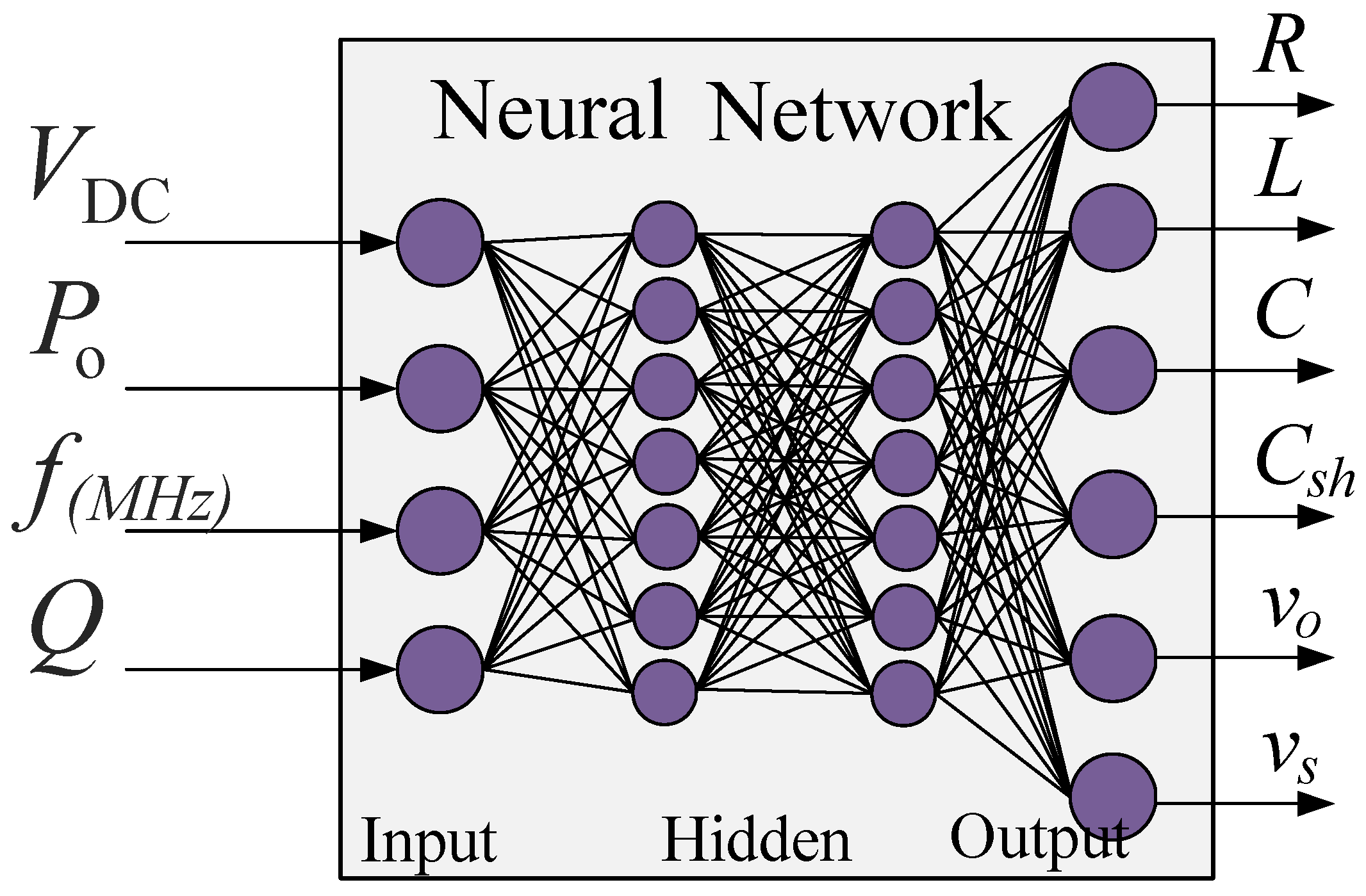
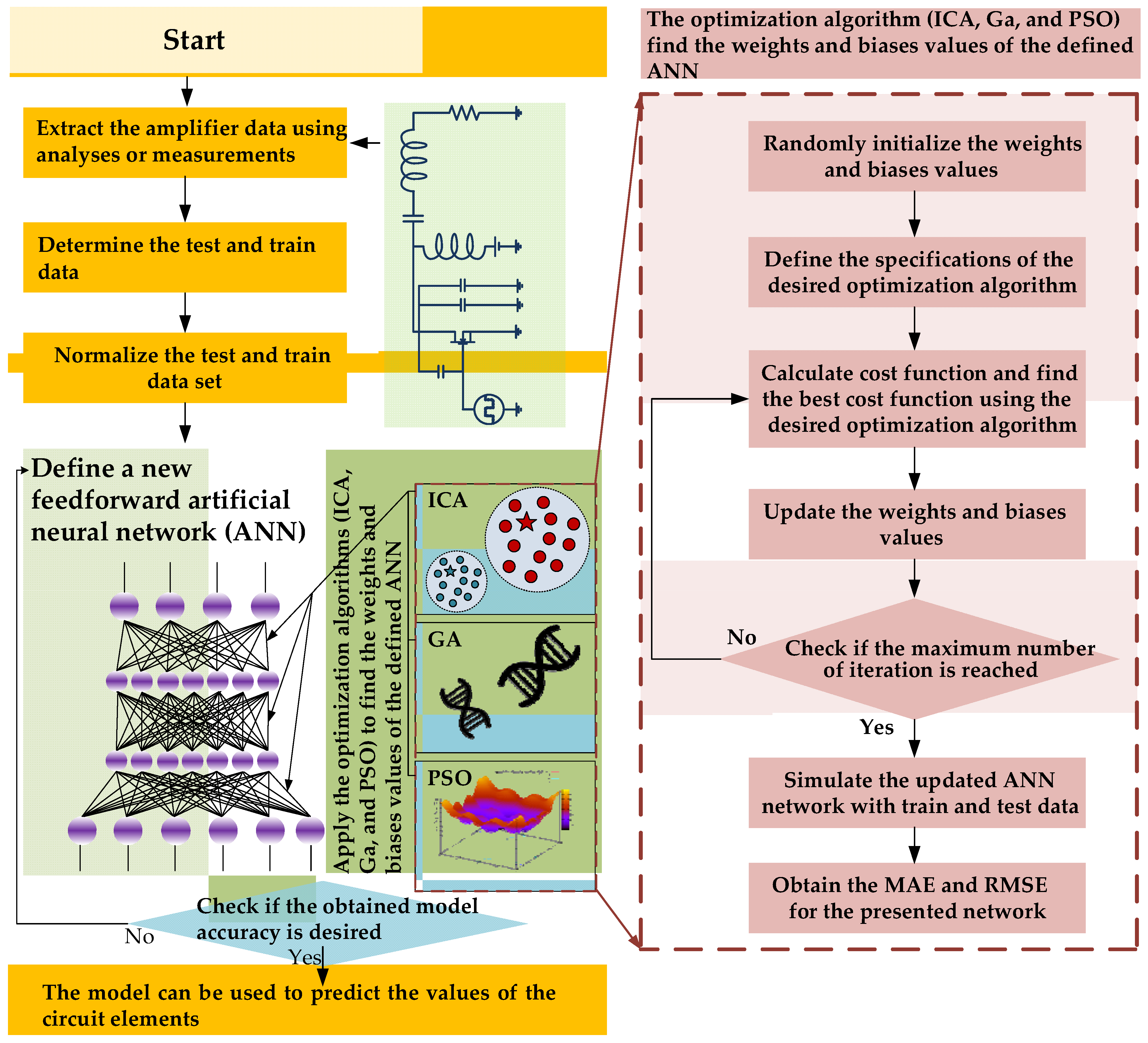

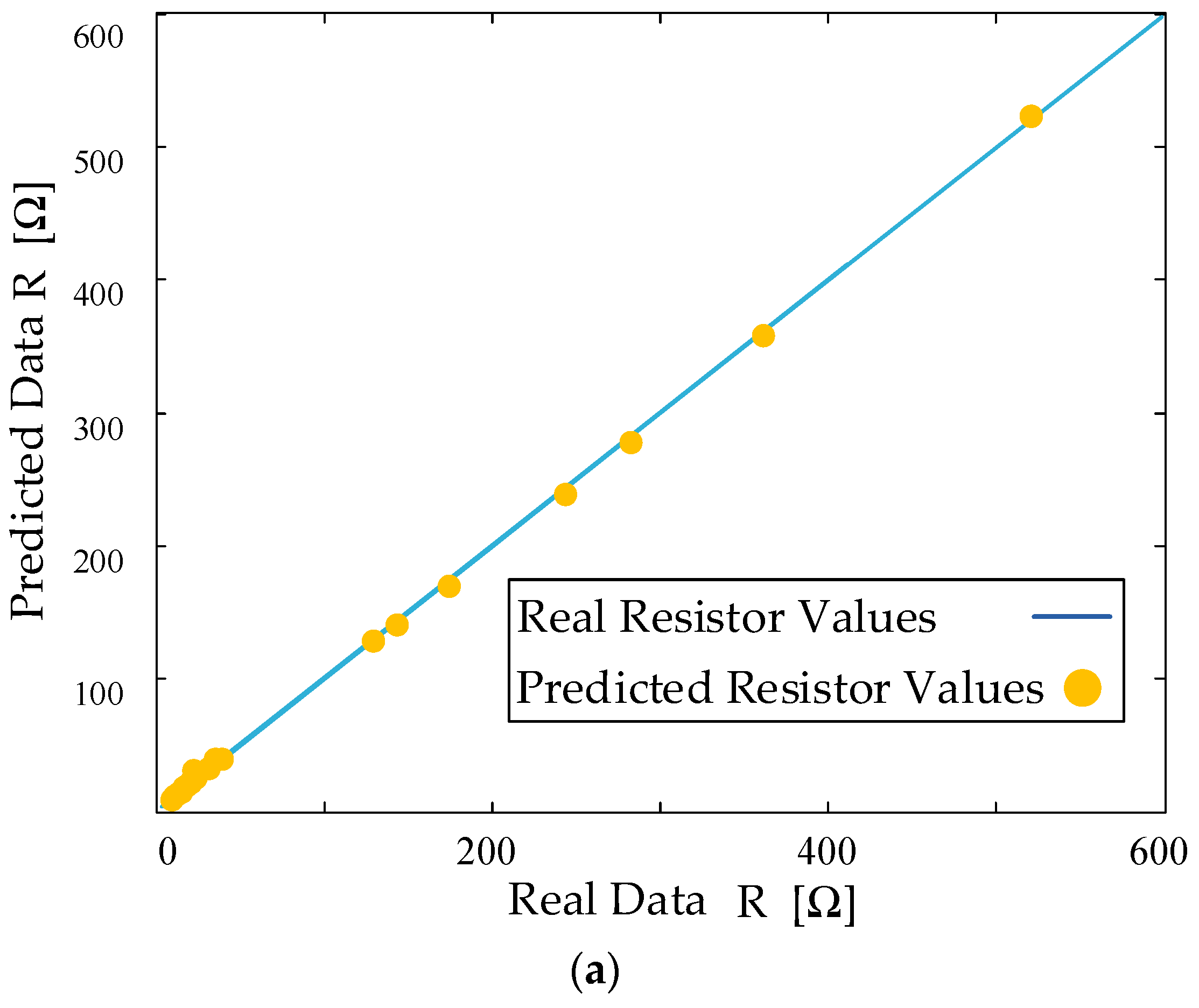
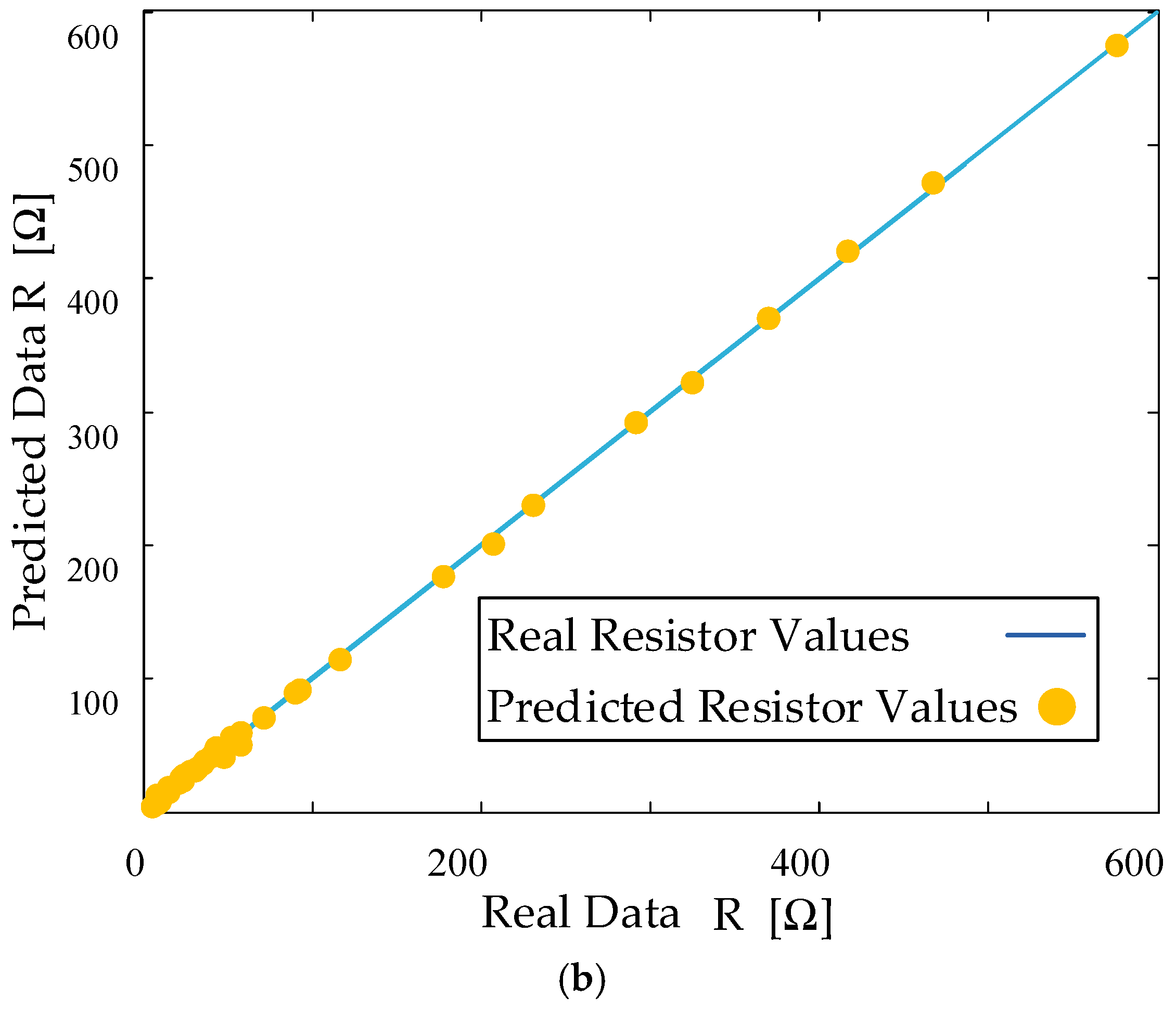
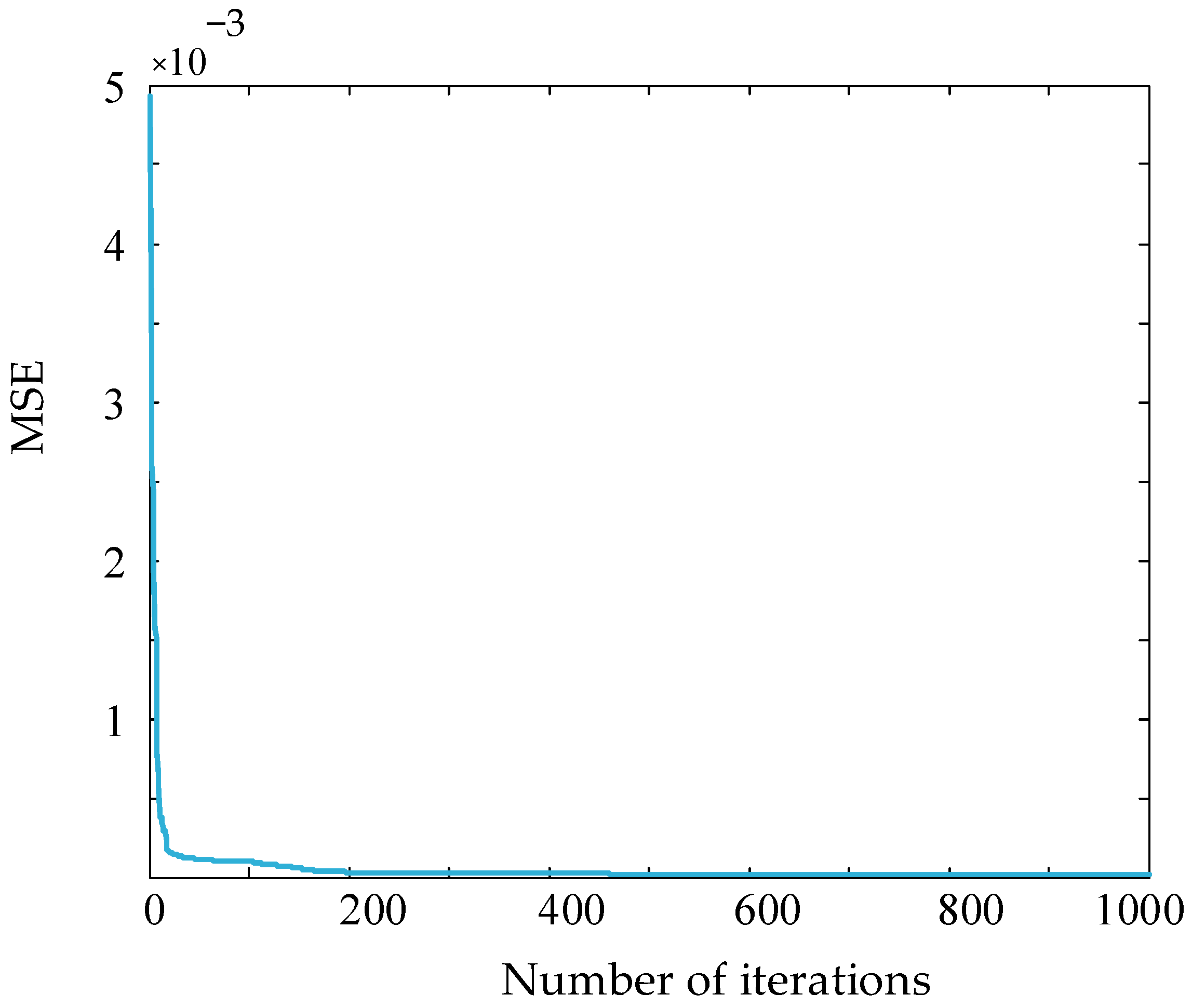
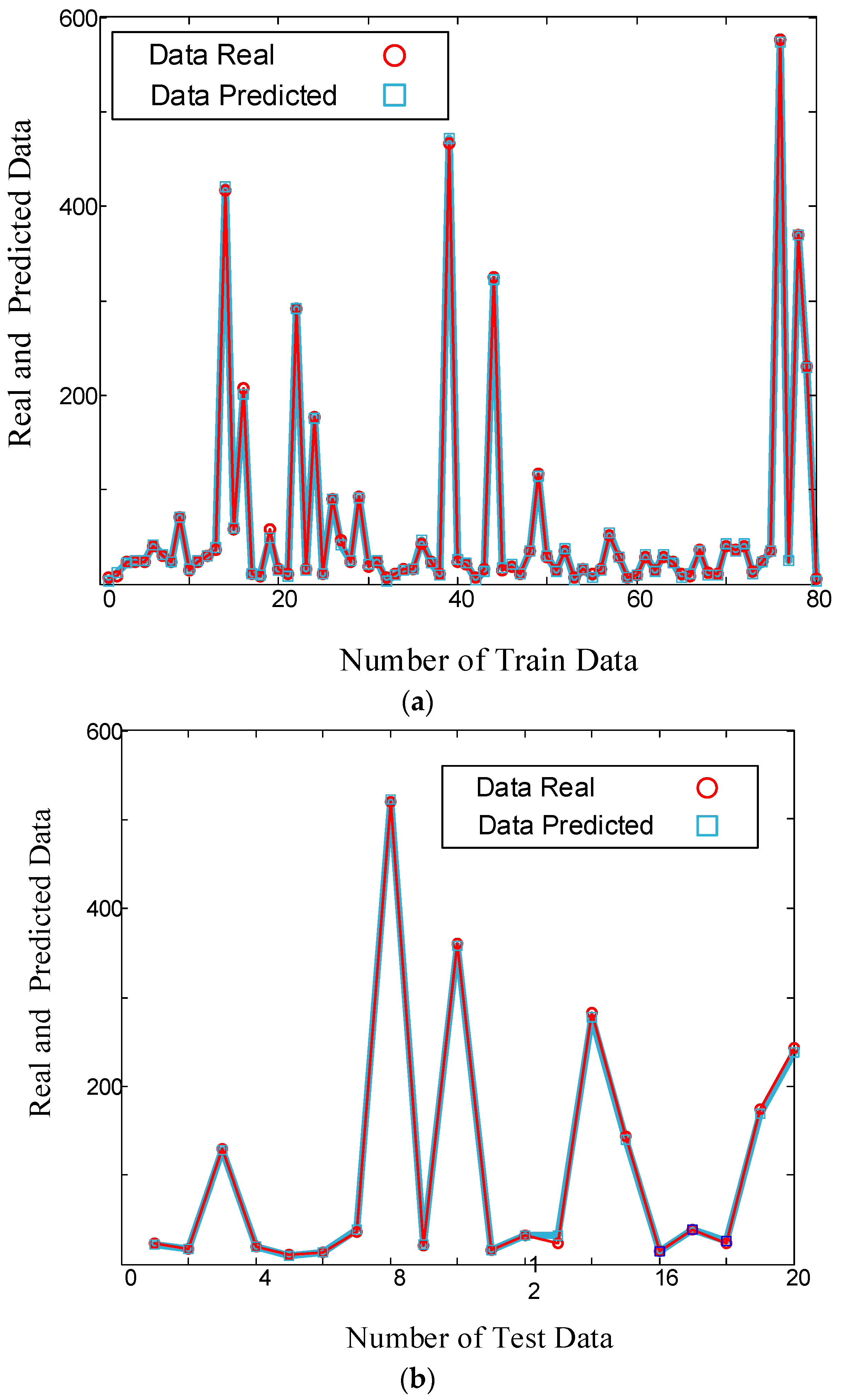
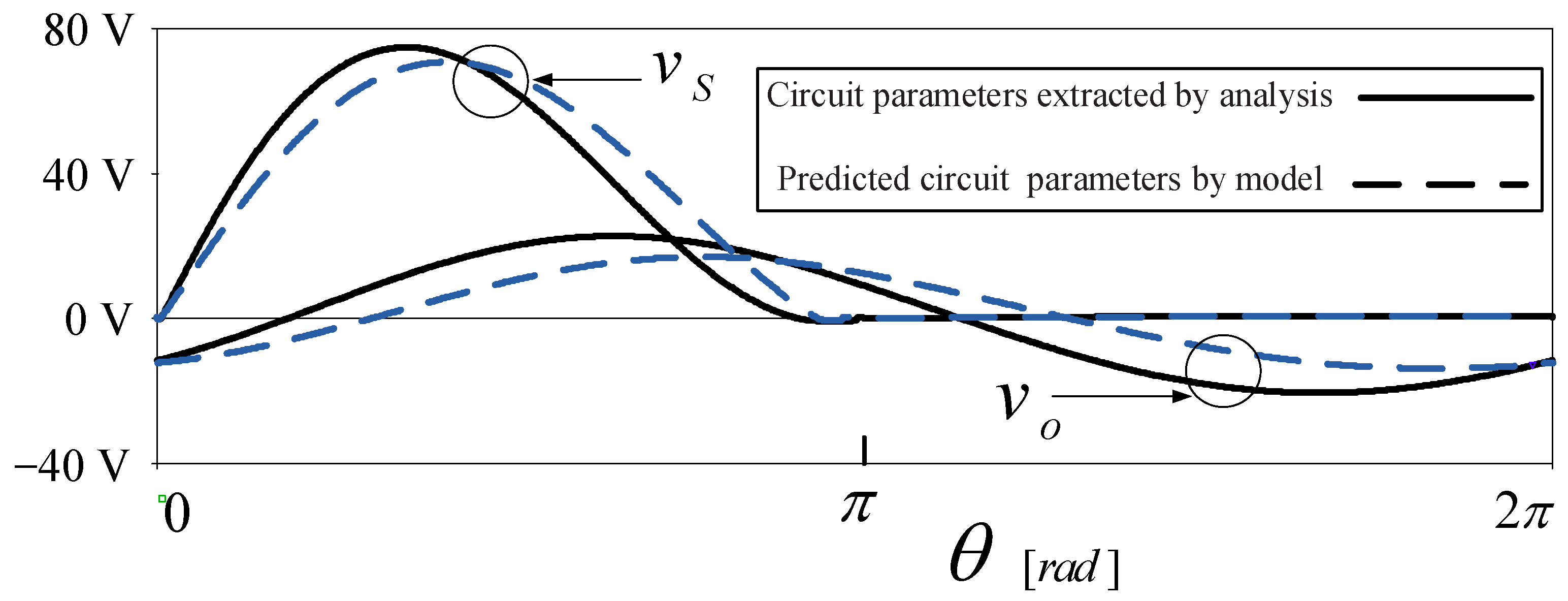
| Error | ANN-PSO Test | ANN-PSO Train | ANN-PSO Test (Normalized Data) | ANN-PSO Train (Normalized Data) |
|---|---|---|---|---|
| MAE, R (Ω) | 2.39 | 1.91 | 0.0042 | 0.0034 |
| RMSE, R (Ω) | 3.40 | 2.38 | 0.0060 | 0.0042 |
| MAE, L (uH) | 3.63 | 2.43 | 0.0040 | 0.0027 |
| RMSE, L (uH) | 4.45 | 3.10 | 0.0049 | 0.0034 |
| MAE, C (nF) | 0.1 | 0.11 | 0.0252 | 0.0290 |
| RMSE, C (nF) | 0.12 | 0.17 | 0.0310 | 0.0444 |
| MAE, Csh (nF) | 0.11 | 0.14 | 0.0220 | 0.0283 |
| RMSE, Csh (nF) | 0.13 | 0.21 | 0.0268 | 0.0421 |
| MAE, vo (V) | 0.19 | 0.11 | 0.0021 | 0.0012 |
| RMSE, vo (V) | 0.27 | 0.15 | 0.0028 | 0.0016 |
| MAE, vs (V) | 0.65 | 0.49 | 0.0020 | 0.0015 |
| RMSE, vs (V) | 0.86 | 0.66 | 0.0027 | 0.0021 |
| Mean Value–MAE | 1.17 | 0.86 | 0.0099 | 0.0110 |
| Mean Value–RMSE | 1.53 | 1.11 | 0.0124 | 0.0163 |
| Errors | Proposed Model Training | Proposed Model Testing |
|---|---|---|
| MAE | 0.0110 | 0.0099 |
| RMSE | 0.0163 | 0.0124 |
| Input Parameters | Considered Values | Output Parameters | Analyses Result Values | Model Result Values | Relative Error |
|---|---|---|---|---|---|
| VDC (V) | 20 | R (Ω) | 23.07 | 25.07 | 0.086 |
| Po (W) | 10 | L (uH) | 36.72 | 39.64 | 0.079 |
| f (MHz) | 1 | C (pF) | 779.6 | 802.0 | 0.028 |
| Q | 10 | Cex (pF) | 1186.5 | 1225.5 | 0.032 |
| vo (V) | 21.48 | 21.43 | 0.002 | ||
| vsm (V) | 71.24 | 70.87 | 0.005 |
| Input Parameters | Considered Values | Output Parameters | Analyses Result Values | Model Result Values | Relative Error |
|---|---|---|---|---|---|
| VDC (V) | 20 | R (Ω) | 23 | 24.3 | 0.057 |
| Po (W) | 10 | L (uH) | 20.4 | 18.7 | 0.083 |
| f (MHz) | 1.8 | C (pF) | 433.2 | 484.6 | 0.118 |
| Q | 10 | Cex (pF) | 623.6 | 518.8 | 0.168 |
| vo (V) | 21.4 | 21.3 | 0.004 | ||
| vsm (V) | 71.2 | 71.3 | 0.001 |
Publisher’s Note: MDPI stays neutral with regard to jurisdictional claims in published maps and institutional affiliations. |
© 2022 by the authors. Licensee MDPI, Basel, Switzerland. This article is an open access article distributed under the terms and conditions of the Creative Commons Attribution (CC BY) license (https://creativecommons.org/licenses/by/4.0/).
Share and Cite
Yahya, S.I.; Alameri, B.M.; Jamshidi, M.; Roshani, S.; Chaudhary, M.A.; Ijemaru, G.K.; Mezaal, Y.S.; Roshani, S. A New Design Method for Class-E Power Amplifiers Using Artificial Intelligence Modeling for Wireless Power Transfer Applications. Electronics 2022, 11, 3608. https://doi.org/10.3390/electronics11213608
Yahya SI, Alameri BM, Jamshidi M, Roshani S, Chaudhary MA, Ijemaru GK, Mezaal YS, Roshani S. A New Design Method for Class-E Power Amplifiers Using Artificial Intelligence Modeling for Wireless Power Transfer Applications. Electronics. 2022; 11(21):3608. https://doi.org/10.3390/electronics11213608
Chicago/Turabian StyleYahya, Salah I., Ban M. Alameri, Mohammad (Behdad) Jamshidi, Saeed Roshani, Muhammad Akmal Chaudhary, Gerald K. Ijemaru, Yaqeen Sabah Mezaal, and Sobhan Roshani. 2022. "A New Design Method for Class-E Power Amplifiers Using Artificial Intelligence Modeling for Wireless Power Transfer Applications" Electronics 11, no. 21: 3608. https://doi.org/10.3390/electronics11213608
APA StyleYahya, S. I., Alameri, B. M., Jamshidi, M., Roshani, S., Chaudhary, M. A., Ijemaru, G. K., Mezaal, Y. S., & Roshani, S. (2022). A New Design Method for Class-E Power Amplifiers Using Artificial Intelligence Modeling for Wireless Power Transfer Applications. Electronics, 11(21), 3608. https://doi.org/10.3390/electronics11213608












